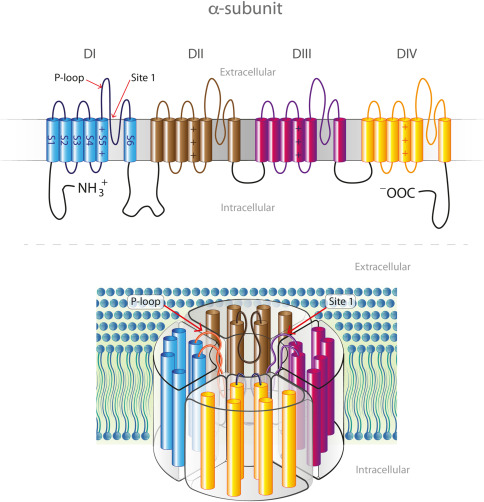
Sodium Channels (Physiology 2)
Sodium channels Voltage-gated sodium channels termed NaV1.x are encoded by the genes SCNA1-9. They are formed from one large protein comprised of 4 repeated regions and each has 6 transmembrane domains (See Figure 1A). The 4th transmembrane domain of each region is packed with positively charged amino acids and is known as the voltage sensor. These are highlighted in panel A and shown as grey tubes in panel B bottom. When the membrane potential gets less negative (depolarises) the voltage sensor domains move out of the plain of the membrane (in the middle panel of Fig 1B bottom the grey tubes are now poking up). This allows sodium ions to pass through the pore - the channel is activated or open. However, sodium flow is brief because a few ms later the so called inactivation 'lid' part of the channel then moves to and occludes / blocks the channel pore (Panel B bottom right). In this state their is no flow of sodium but the voltage sensors are still poking up so the channel is not closed but is INACTIVATED. Any mechanism including mutations to the gene that affects the property of inactivation will allow for longer / more persistent sodium influx. VGSC picture.png In skeletal muscle SCNA4 is expressed and the expression product NaV1.4 is crucial for converting the excitatory junction potential provided by nicotinic acetylcholine receptor activation into broad excitation down the t-tubule system.
-
What is the name of the voltage-gated sodium channels? (1)
The voltage-gated sodium channels are termed NaV1.x.
-
What genes encode NaV1.x sodium channels? (1)
The genes SCNA1-9 encode NaV1.x sodium channels.
-
What is the structure of a voltage-gated sodium channel? (2)

The channel is formed from one large protein comprised of 4 repeated regions.
Each region has 6 transmembrane domains.
-
What is the voltage sensor in sodium channels? (1)
The 4th transmembrane domain of each region is packed with positively charged amino acids and is known as the voltage sensor.
-
What happens when the membrane potential becomes less negative (depolarizes)? (2)
The voltage sensor domains move out of the plane of the membrane.
This movement allows sodium ions to pass through the pore, activating the channel.
-
What is the state of the sodium channel when it is open? (1)
When the sodium channel is open, sodium ions flow through the pore.
-
What happens after sodium ions flow through the pore? (1)
A few milliseconds later, the inactivation 'lid' of the channel moves to block the pore, stopping sodium flow.
-
What is the inactivated state of the sodium channel? (1)
In the inactivated state, the channel is blocked and there is no sodium flow, but the voltage sensors are still up, so the channel is not closed.
-
What causes sodium channels to become inactivated? (1)
The inactivation is caused by the movement of the 'lid' part of the channel to occlude/block the pore.
-
What happens if a mutation affects the inactivation property of sodium channels? (1)
Mutations affecting inactivation lead to longer or more persistent sodium influx.
-
What is the primary function of voltage-gated sodium channels? (1)
The primary function is to regulate the flow of sodium ions into the cell during depolarization.
-
How do voltage-gated sodium channels contribute to action potentials? (2)
They open when the membrane depolarizes, allowing sodium to enter the cell and further depolarize the membrane.
This contributes to the rapid rising phase of the action potential.
-
What is the role of the 4th transmembrane domain in sodium channels? (1)
The 4th transmembrane domain acts as the voltage sensor in sodium channels.
-
What is the significance of the voltage sensor in sodium channels? (1)
The voltage sensor detects changes in membrane potential and initiates channel opening.
-
What happens if there is a persistent influx of sodium ions due to mutation? (1)
A persistent influx of sodium ions can lead to prolonged depolarization and altered cellular function, potentially causing diseases like epilepsy.
-
What is the 'lid' in the sodium channel's inactivation process? (1)
The 'lid' is a part of the sodium channel that moves to block the pore, preventing sodium ions from passing through after activation.
-
What are the effects of channel inactivation on sodium flow? (1)
Channel inactivation stops sodium flow, even though the voltage sensors are still up.
-
What factors can influence the inactivation of sodium channels? (1)
Factors such as mutations, changes in membrane potential, and temperature can affect inactivation.
-
What does a prolonged sodium influx lead to? (1)
Prolonged sodium influx can lead to pathological conditions like hyperexcitability of cells and neurological disorders.
-
Why is inactivation important for proper sodium channel function? (1)
Inactivation prevents excessive sodium influx, ensuring the proper timing and regulation of action potentials.
-
What is the duration of the sodium channel's open state during an action potential? (1)
The sodium channel remains open for only a few milliseconds during an action potential before inactivation occurs.
-
How does depolarization affect the voltage sensor in sodium channels? (1)
Depolarization causes the voltage sensor to move out of the membrane's plane, initiating channel opening.
-
What is the impact of mutations in SCNA1-9 genes? (2)
Mutations in these genes can affect the function of sodium channels, leading to disorders such as channelopathies.
These disorders may include prolonged or abnormal sodium influx due to faulty inactivation.

